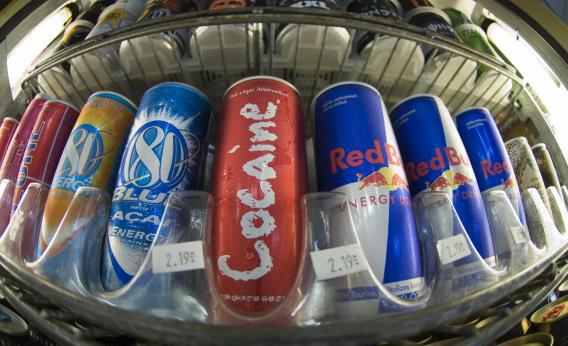Last week, a friend told me that her son had gone to the school nurse in his elementary school because of dizziness, shakiness, palpitations, and nausea. Her first thought was that he’d come down with a stomach virus. It turned out that he’d sampled a new energy drink called MiO. According to the manufacturer’s page, MiO is a flavored “liquid water enhancer” packaged in palm-sized squeeze bottles in several varieties, including two caffeine-containing “energy” versions. It’s intended to make water more exciting. (Per the homepage, “Water’s great and all, but sometimes it’s like a yawn in a glass.”) One serving of MiO Energy (a half-teaspoon squirt) purportedly contains 60 milligrams of caffeine, about the same as a cup of coffee. For a caffeine-naive child, multiple squirts must have had the physical effect of a couple of mega-caffeine Pike Place Roasts. (Not to mention that many energy drinks contain additives like guarana, which themselves contain large amounts of caffeine.)
Some energy drinks are marketed as food while others are pitched as “dietary supplements”; the Dietary Supplement Health and Education Act of 1994 frees manufacturers from FDA regulation. And so energy drinks and liquid water enhancers like MiO, by including vitamins, minerals, herbs, or amino acids in their ingredients, have gained admission into the libertarian paradise of dietary and nutritional supplements—even though there’s nothing nutritious about them. We don’t know how much caffeine lurks within the snazzy bottles, but it’s clear that it’s too much for the elementary school set. According to a 2011 paper on health effects of energy drinks on children, children shouldn’t have more caffeine than 2.5 milligrams per kilogram per day; since the FDA limits 71 milligrams of caffeine per a 12-ounce can of soda, that’s about one soda a day, not a soda plus a couple of shots of MiO Energy.
Many high schools and middle schools ban energy drinks (which are not the same as sports drinks or vitamin waters) because of the caffeine content. It’s less clear whether this is a widespread practice in elementary schools, but it should be. Young kids (and their parents, and their teachers) need to know caffeine’s potential health risks. We can’t count on the manufacturers, whose gimmicky ads designed to appeal to youngsters make me think of those ubiquitous Joe Camel ads back in the ’90s. Parents need to know the difference between sports drinks and energy drinks, and energy drink labels should clearly state the total caffeine content—including the amount in additives like guarana. Schools need to include information about caffeine-drenched energy drinks in their discussions of substances to avoid. Schoolkids and megadoses of caffeine are not a good combination, and, with products like the inhalable caffeine Aeroshot now hitting the market, the story is far from over.
